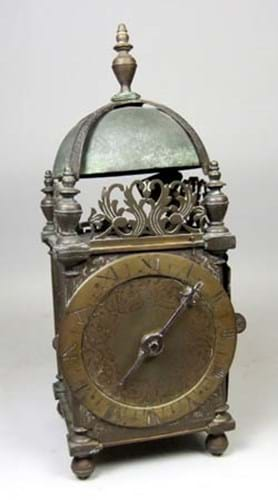
Although catalogued as William III and estimated at £700-1000, the 15in (39cm) clock is certainly from the so-called First Period of lantern clock making and probably as early as 1610-20.
The round-shouldered urn finials, a single 'ring of roses' dial pattern, ringed ball feet and the hand design are all Jacobean features, putting the clock close in time to the first true lantern clocks recorded - those signed for Robert Harvey c.1602-15.
The West Norwood clock was thought to be by his younger brother Thomas, who was made free in the Clothworkers' Company in 1615, but working as an apprentice for the family firm before his brother's death.
Although the frets were replacements and the balance wheel movement later converted to an anchor escapement, there was plenty of confidence in its authenticity - helped by a generous layer of dirt suggesting it had not been cleaned for over a century.
There were nine interested parties with bidding on phones, the internet and in the room. Although the auctioneer opened proceedings at £1000, pre-emptive bids of £7000 and then £13,000 were tendered by a bidder in the room before two other combatants took the final price to £29,000.
It was sold to East Sussex clock specialist W.F. Bruce Antiques of Lewes. Bill Bruce, who told ATG he concurred with the suggestion that this was a very early clock, perhaps by London maker Thomas Harvey c.1610-20, will include it in an exhibition of lantern clocks he is planning for the end of the year. He would be interested to hear from owners of similar First Period lantern clocks.
Contact: 01273 473 123 or email: web@wfbruce.co.uk
The buyer's premium was 17.5%.
By Roland Arkell




